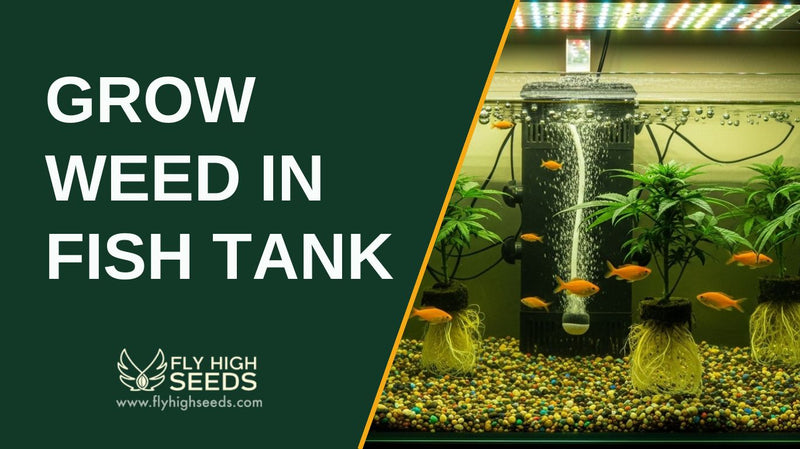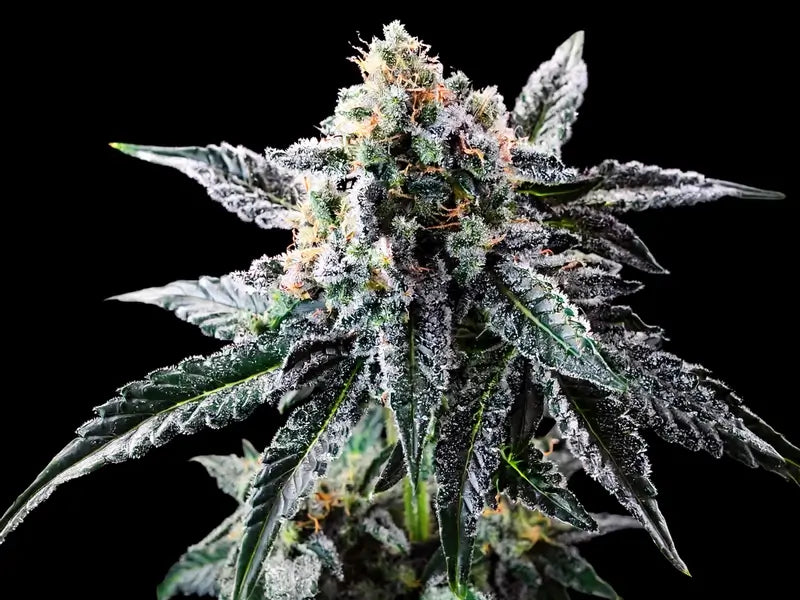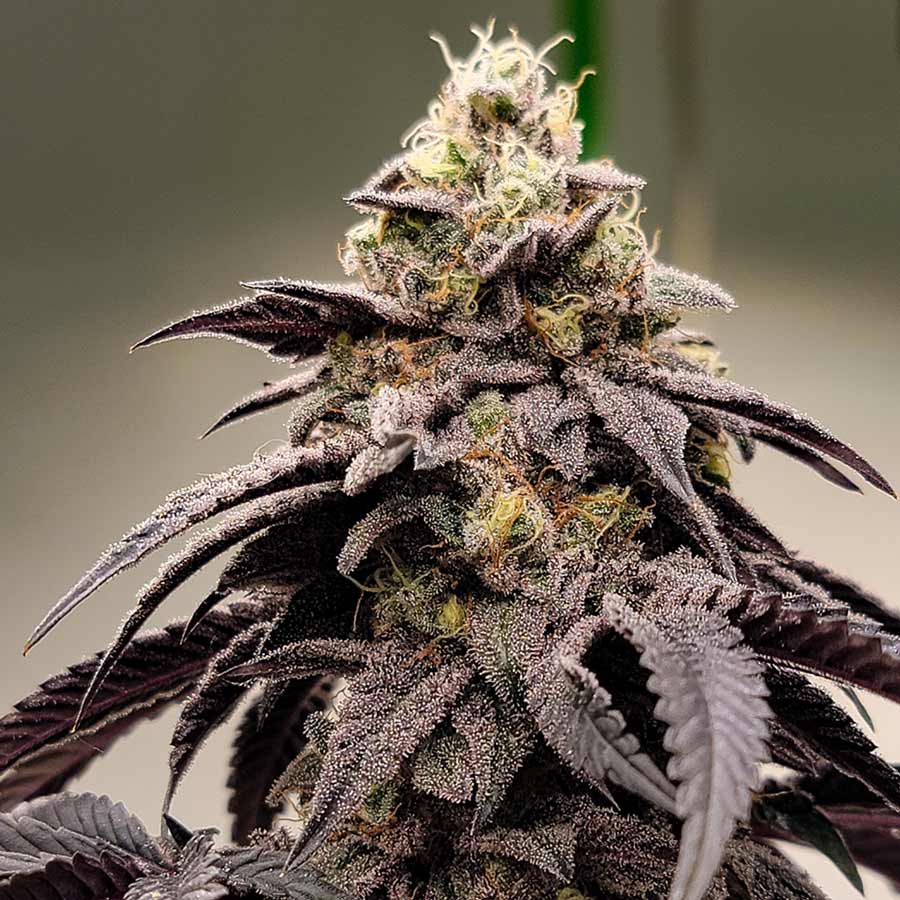How to Grow Weed in Fish Tank: 7 Steps to Setup Aquaponics

Combining aquaculture and cultivation, aquaponics offers a sustainable way to grow weed in fish tank environments. This system uses the waste from fish to feed cannabis plants, creating a natural cycle that supports both aquatic and plant life. For growers looking to learn low maintenance and eco-friendly methods, this setup blends innovation and simplicity.
Can You Grow Weed in Fish Tanks?
Yes, you can grow weed in fish tanks by using aquaponics. This method connects fish tanks with a hydroponic system, where fish waste becomes a natural source of nutrients for growing cannabis.
Through a well-balanced aquaponics setup, plant roots absorb nutrients from the water as bacteria break down fish waste into usable forms like nitrates. The process supports vegetative growth and flower production while offering a sustainable, soil-free option for marijuana cultivation.
How to Grow Weed in a Fish Tank
To start growing cannabis using an aquaponics system, you’ll need to create a balance between aquatic life and plant growth. The following steps guide you through selecting the right equipment, setting up the system, and maintaining healthy weed and fish together.
1. Select the Right Tank and Fish
Choose a large enough aquarium or fish tank to support both the fish and plants. Tanks with at least 20 gallons of water are recommended. Suitable fish options include tilapia, goldfish, or koi, which are hardy and produce consistent waste. Avoid fish that require specialized care or produce too much heat.
2. Build or Purchase an Aquaponics System
You’ll need a basic aquaponics system that includes a media bed, water pump, grow tray, and filtration. The media bed holds your plants while allowing robust roots to develop. Ensure the system provides continuous water flow between the fish tank and root zone.
3. Add a Growing Medium
Instead of soil, use a growing medium like expanded clay pellets or gravel in your media bed. This helps support plant roots and provides space for beneficial bacteria to convert ammonia into plant-available nutrients. A well-aerated medium promotes healthy growth and prevents algae buildup.
4. Start Cycling the System

Before adding seeds or seedlings, allow time for bacteria colonies to develop. This cycling process typically takes 3–4 weeks. During this time, fish waste accumulates, and the bacteria begin converting solid waste into nutrients. Monitor ph levels and ammonia to avoid toxicity.
5. Choose and Plant Cannabis Strains
Select cannabis strains known to thrive in hydroponics. Start growing from seeds or clones and place them gently in the media bed. Ensure light exposure is optimal for vegetative growth and flowering stages. LEDs or full-spectrum grow lights offer the best control in indoor setups.
6. Monitor and Maintain the System
Maintain nutrient levels, water temperature, and oxygen flow in the tank. Check the health of both fish and plants regularly. Remove solid waste buildup, adjust potassium or other nutrient deficiencies, and ensure the root zone remains clean and oxygenated.
7. Harvest Buds and Rebalance the System
Once flowering ends, harvest your buds and prepare the system for another cycle. Clean the medium and equipment as needed to prevent disease or imbalance. As with any garden system, long-term success depends on proper control, observation, and maintenance.
Benefits of Using Aquaponics for Cannabis Plants
Aquaponics provides a natural and efficient way to grow cannabis by merging hydroponics and aquaculture. This system reduces waste, increases sustainability, and supports healthier plant growth without synthetic nutrients.
Sustainable Nutrient Source
Fish waste naturally feeds growing cannabis plants, eliminating the need for chemical fertilizers and reducing environmental impact.
Healthier Root Development
The continuous water flow keeps plant roots oxygenated and nourished, promoting robust roots and faster vegetative growth.
Space Efficiency
Aquaponics allows for growing weed in compact spaces like aquariums or indoor tanks, making it ideal for small-scale setups.
Low Maintenance
Once balanced, the system requires minimal intervention. Most people find aquaponics easier to manage over time than soil-based farming.
Dual Production
Growers can harvest both cannabis and fish like tilapia or goldfish, offering a source of food and medicine in one closed-loop system.
Tips for Better Yields Using Aquaponics
Growing cannabis in aquaponics can be productive and rewarding if managed carefully.
These tips can help improve results and quality:
- Use hardy fish: Tilapia and koi adapt well to varied conditions and consistently produce useful waste
- Monitor water quality: Keep ph levels stable and ammonia low to support healthy growth
- Add supplemental lighting: Use strong full-spectrum grow lights to encourage flowering and increase bud density
- Avoid overcrowding: Too many plants or fish in one tank disrupts nutrient balance and oxygen flow
- Clean filters regularly: Remove excess solid waste to prevent buildup and system blockage
- Choose the right strains: Some cannabis strains grow faster and respond better in hydroponic systems
- Watch nutrient levels: Ensure the plants get enough potassium and other key elements during different growth stages
-
Prevent algae growth: Limit light exposure to the tank to avoid algae, which competes for nutrients
Final Thoughts

Growing weed in fish tank systems through aquaponics blends nature and innovation. This method offers a rewarding way to cultivate high-quality cannabis with lower environmental impact and ongoing benefits. Whether you’re just starting or looking to upgrade your garden, aquaponics is a system worth learning for sustainable results.
For those interested in sustainable growing methods, learning aquaponics can be a practical step toward more efficient cannabis cultivation. Consider learning more about setup techniques, compatible plant strains, and system maintenance to maximize your success.
Frequently Asked Questions
Can you use any type of fish in an aquaponics system for cannabis?
Not all fish are suitable. Use hardy species like tilapia, koi, or goldfish that thrive in enclosed environments and produce consistent waste.
Do cannabis plants grown in aquaponics taste different?
No, the taste and quality of buds are influenced more by genetics and environmental conditions than by the growing system.
How do you prevent disease in an aquaponics system?
Regular maintenance, clean water, and balanced nutrient levels reduce the risk of root rot, algae, or fish diseases.
Can I grow vegetables alongside cannabis in the same system?
Yes, many growers cultivate vegetables like lettuce or herbs alongside cannabis, as long as the nutrient and light needs are compatible.
Is aquaponics cheaper than traditional soil growing?
Initial setup may cost more, but long-term savings come from reduced nutrient purchases and water use, making it cost-effective over time.



